5 unavoidable facts that prove jumps racing is dangerous for horses and inhumane
September 03, 2018South Australia’s 2018 jumps racing season finally drew to a close on Saturday – but not before yet another horse suffered a terrible fall that could well cost him his life.
Nine-year-old gelding Darebin fell heavily at the final jump of Race 2 at Morphettville Racecourse, landing on his neck and rolling completely over. The steward’s report states he is now lame in his near foreleg and will need veterinary clearance before racing again.
Should he be euthanased because of the injuries he sustained during this bad fall, the general public may never know.
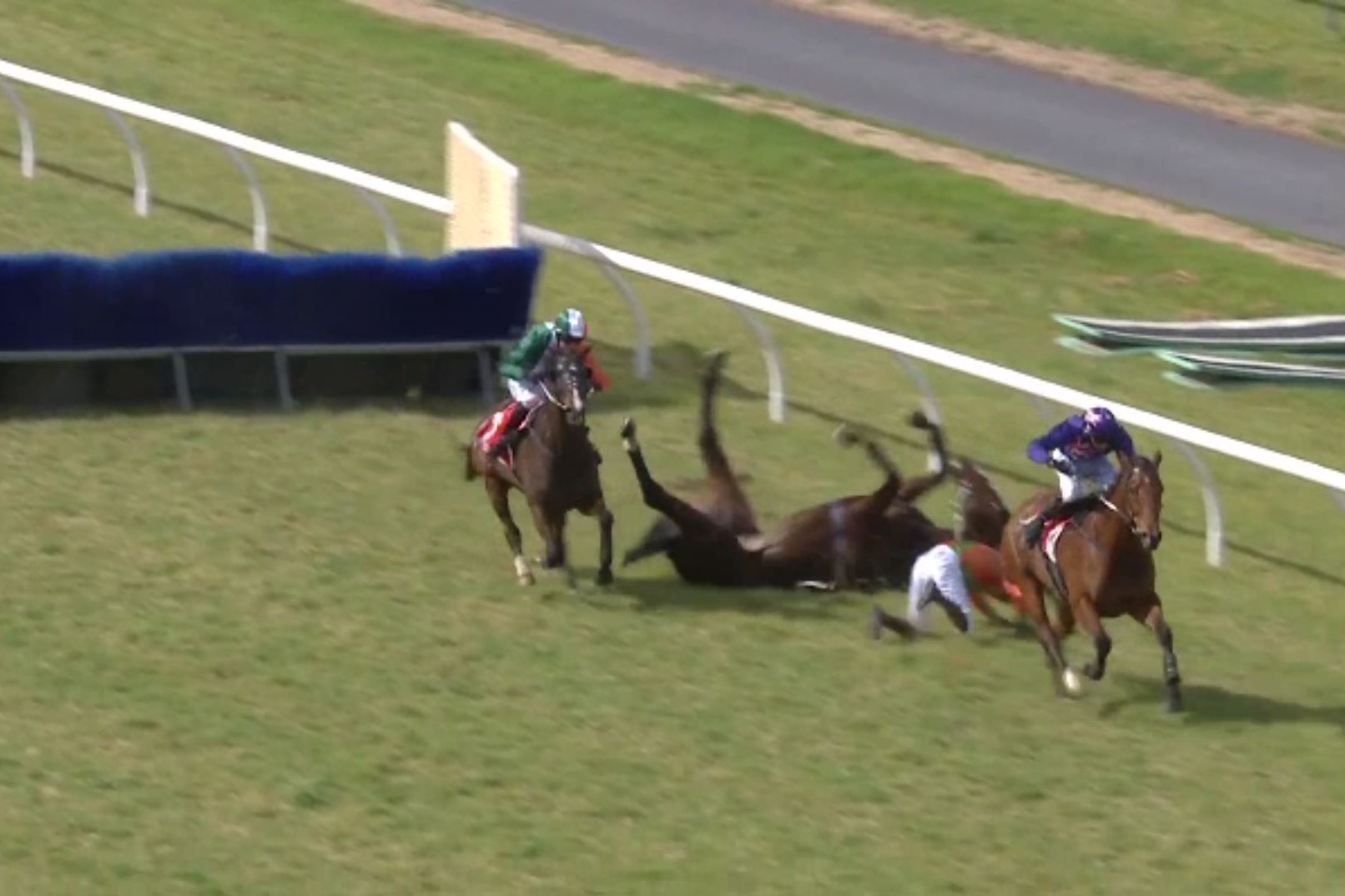
Thoroughbred Racing South Australia has reported one horse death during SA’s 2018 jumps racing season, but the death toll may actually be far higher.
It is difficult to know the true number of fatalities from jumps racing in South Australia, as stewards’ reports on trials are not made public. Likewise, horses like Darebin that fall during a race, and may be euthanased days or weeks later as a direct result, will not be reported by the sector as a death due to injury. These horses will simply be reported as ‘retired’ or ‘deceased’, therefore the sector’s fatality figure (due to racing) will be an under-estimate.
It’s clear that jumps racing puts horses at unacceptable risk of injury and death. Here are five reasons why we believe 2018 simply must be the last time horses are forced to race over jumps in South Australia.
1. Horses are not designed for jumping over obstacles at speed
Some people believe horses are made for jumps racing. An understanding of their physiology makes it clear that they are not. Horses have:
- Laterally placed eyes which restricts forward vision and their ability to judge the distance and position of an approaching obstacle at speed.
- Heavy frames which makes it difficult to lift their own weight over obstacles.
- An inflexible spine which makes it physically difficult to compensate for jumping errors.
- Long limbs which become extended when galloping, making it difficult to adjust stride as they approach jumps at high speed.
Jumps racing pushes horses far beyond their natural limits. It exposes these animals to a much higher risk of musculoskeletal injuries, physiological stress, other injuries and death when compared to flats racing.
2. Horses do not “love to jump”
Some people (usually those who profit from jumps racing) would like us to believe that horses love to jump. Again, this is incorrect.
Horses only jump obstacles at full gallop because they are forced to do so.
Horses are intelligent animals with a high level of perception of their environment. If they approached an obstacle that required jumping over in the natural environment, the horse’s reaction would be to slow down, assess the obstacle and adjust their gait accordingly.
If you watch a show-jumping or eventing competition, you will see riders deliberately slow their horses as they approach an obstacle. This helps the horse to steady itself, to judge the height and to jump cleanly.
Although there are still risks involved in these equestrian sports, they are far less than those experienced by a racehorse being forced by a whip-yielding jockey at flat gallop alongside other horses over obstacles.
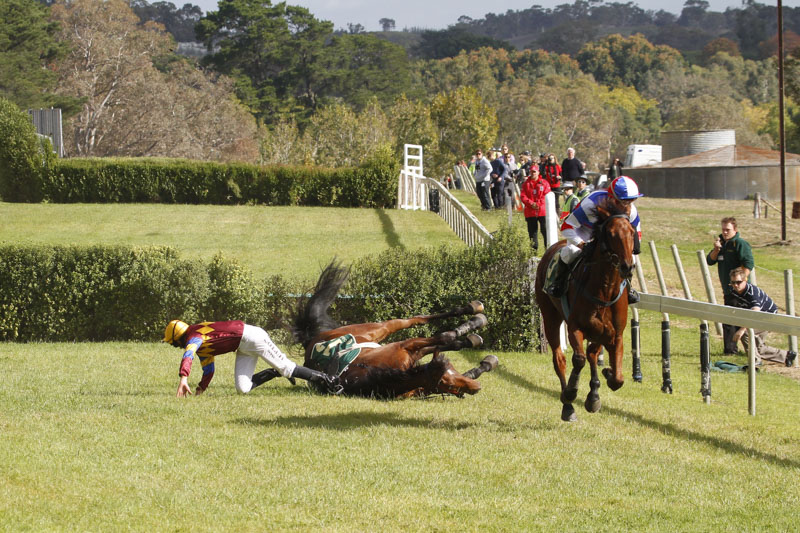
Travelling at speed, these horses are not given sufficient time to assess the hurdle and can misjudge height and/or width, leading to falls. This ‘judgement’ is further compromised when many horses are jumping the same jump simultaneously.
Survival instincts mean that horses are unlikely to jump over obstacles at full speed and risk injury or death. Most horses that lose their riders during jumps races (which happens frequently) choose to run around hurdles and steeples where they can rather than to continue jumping.
(Compared to flat races, jumps races have a higher rate of horses failing to finish. Nearly 20% of starters fail to cross the finish line for a variety of reasons. Horses that do finish often struggle many tens of lengths after the winner and are never in contention. Sadly, this doesn’t stop some riders continuing to whip their horses even though they have no chance of success.)
3. Jumps races are longer than flat races and the horses are often older
The two longest horse races in Australia are jumps races. They are more than three times the length of an average flat race, which is 1500 metres.
The Grand Annual Steeple, which is the main feature race of Warrnambool’s May Racing Carnival, is officially listed as about 5500 metres because many sections of the race are run in open paddocks with few fences.
Horses competing in this race must clear 33 obstacles, more than any other steeplechase in the world. Twelve horses died in jumps races at the Warrnambool track in the eight years from 2008 to 2017 and many more have been injured.
The second longest horse race in Australia is Oakbank’s Great Eastern Steeplechase. This feature race of the Oakbank Easter Racing Carnival is 4950 metres long. Horses must clear a total of 24 obstacles.

The physical toll these races take on the horses is plain to see. Many don’t make it to the finish line. Those that do exhibit symptoms of severe physiological stress. In some cases, this stress is so severe that horses die within days of racing.
In 2011, Zendi, an 8 year old gelding trained by Ballarat-based Damien Hunter, collapsed and died of a heart attack just a week after winning his owners $101,000 in the 3.2km long Galleywood Hurdle at Warrnambool.
In July 2018, About the Journey died directly after a race at Morphettville. The vet who attended him stated the probable cause of death as a ruptured aorta. This horse’s form immediately prior to this race was poor, raising the question of whether the horse should have been permitted to run at all.
Added to the excessive and cruel physical challenge of jumps racing is the fact that jumps race horses tend to be older than horses that compete in flat races. Just as with humans, the age of a horse can greatly affect its stamina.
One of the oldest horses to die, Bello Signor, trained by Victorian trainer Eric Musgrove, was 11 (roughly the equivalent of 40 in human years) when he broke a leg during a hurdle trial at Casterton and was euthanased. Up until his death he’d earned his owners, including his trainer, nearly $600,000 in prizemoney.
Many jumps horses are horses that have failed to make the grade on the flat. They have often already suffered significant wear and tear on their bodies before they are exposed to the greater strain of jumps racing. Forcing them to race over jumps not only puts their lives at risk but also their jockeys.
The difference is that the jockeys choose to be in that dangerous situation. The horses don’t.
4. The industry is far from transparent about horse deaths and injuries
While Thoroughbred Racing South Australia does report on horses that die during or immediately after a race, this is most certainly not the full picture.
TRSA does not release stewards’ reports of trials, nor reports on post-race day outcomes from falls and injuries sustained during racing. So the statistics don’t tell the full story.
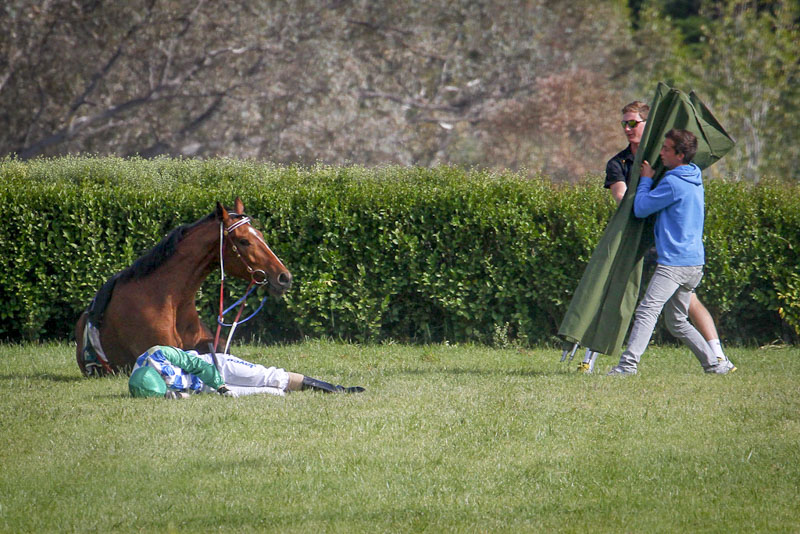
Some deaths caused by jumps racing injuries occur well after the actual race – and well away from public view. These deaths, either by euthanasia or with the injured animal sent to slaughter, are neither reportable nor traceable – unless you look hard.
Above Average is one such horse whose death didn’t make the jumps racing death tally for 2015, the year he ran his final race. A post-race Steward’s Report stated that a Veterinary Certificate of Fitness would be required “prior to presenting the gelding for a future trial or race”.
There was no mention in the report of the horrific incident where the horse slipped after the race finished. Despite regular checking, at least three months passed before Above Average was listed as ‘deceased’.
Likewise, any deaths that occur during trials are never publicly reported.
This means the general public never has the full picture of how many horses die or are injured as a direct result of jumps racing. The reported statistics are always an under-estimate.
5. The ‘spectacle’ of jumps racing is barbaric
There is significant hype around the spectacle of jumps racing, but the truth is a race with a handful of starters is not a spectacle and neither is watching horses and jockeys fall.
RSPCA South Australia is appalled that the sight of horses being driven at high speed over jumps, where any miscalculation can result in a potentially fatal fall, is regarded by some as an exciting spectacle.
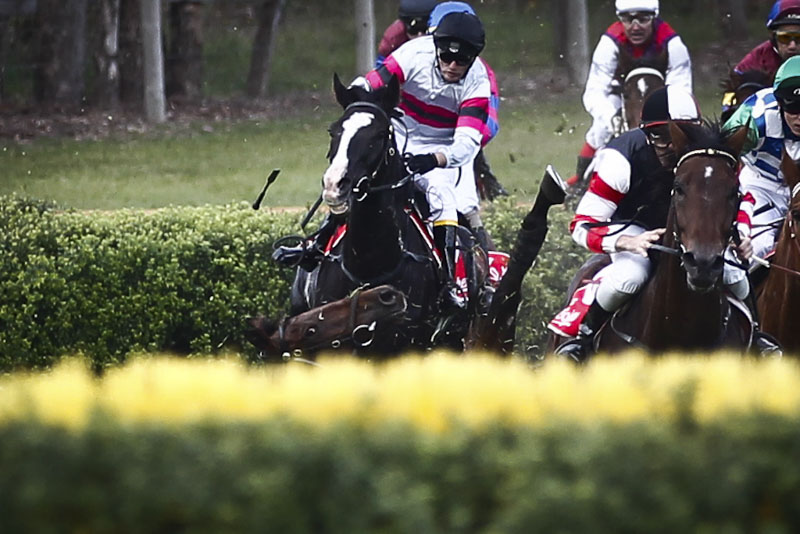
Jumps racing is roulette for horses – horses competing in jumps races are nearly 19 times more likely to die than horses competing in flat races, according to a University of Melbourne study.
Each and every jumps race is a high-risk gamble with injury and death.
It is unnecessary and indefensible in a civilised society for horses to be put at this well-proven risk of injury and death for the entertainment of a minority. The jumps racing industry may try to reduce the risks of falls, but jumps races cannot be made safe. They are inherently dangerous and inhumane.
That’s why RSPCA South Australia is opposed to jumps racing and wants to see all obstacles permanently removed from racetracks. Please join us in calling on South Australia’s leaders to ban jumps racing now.


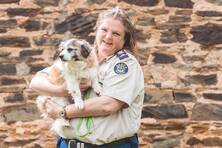
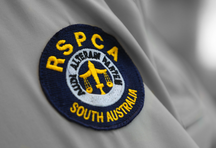

Totally agree with need for immediate ban.
This will stop not only the jumping races of next year but will also stop the preparation of horses across the off season. ( one wonders how many horses are injured by the preparation/training).
Who are ‘starters’ in jump racing? Thank you
Absolutely should be banned. I’d like to see the trainers and owners of these poor animals try to emulate one quarter of that which their charges are expected to do, and adding insult to injury; finish the ordeal off with the caning the horses have to bare. Absolute savagery; we do not need; start by banning the whip. Sport of Kings. Yeah right./
After watching Dream Horse and the documentary called Dark Horse, I was appalled at seeing so many poor horses falling. Every race it seems to happen, at least one. It’s not exciting suspension or a sports spectacle – it is horrific, gut retching, and so sad.
We have two rescued thoroughbred horses who are Seattle Slew grandsons, retired from flat racing. We have given them an easy, loving life. A few years back, I started jumping Seattle Shoofly, and he was wonderful at it. Then we found out he has small bone chips in his front fetlock. The vet said it was still okay to jump him over a limit height of 3 feet. I realized that jumping him was for my own selfish gains, and not his. So I stopped. Of course nothing like these jumps races, but I saw in my training for local jumping events, how a horse sees and jumps a jump, horses are not taking them naturally, but as trained by the trainer to take the jumps as a human devises they should.
Dream Horse is a feel good story, but I also hope that it brings attention to steeplechase race jumping and the cruelty to horses (jockeys as well), but like you wrote, the jockey has a choice.
Having two thoroughbreds, I can tell you they are beautiful souls, willing, attentive, sweet, funny, charming, curious, entertaining, fun, and loving. We ride ours on the hundreds of miles of trails near our home, and with their training, they never spook, they eat up the trails, and they never escalate behavior. I ride them on the roads and they always handle it with grace and calmness. So please, more people adopt retired racehorses. They are excellent on trails for pleasure riding. They trailer and let you do anything because of being handled from birth. I ride western. They can go though a transistion from being a racehorses de-escalate their racing mind and high octane diet instilled by humans – change their diet (a high protein one), give them room, don’t lock them up in a stall constantly. The horse becones totally different, a regular mental state, calm but with spirit to ride. And think of this, these hundreds of race horses going to feedlots, should never be approved for human consumption with all the medicine, supplements, shots, steriods, antibiotics they receive. Yet China and Europe receive tons of horse meat for their human consumption. Think about what ttheyare putting into their human bodies. Racing thoroughbreds in America, most often go straight to a feedlot to be sold once the owner is done with them, then transported to Canada or Mexico to be butchered. Horses are injured in feedlots, and suffer with no vet care.
Anyway, horses deserve better after all they’ve done for mankind. If we were talking about dogs going to feedlots or being treated this way, people would be in an uproar. Horses are considered livestock, maybe that’s what needs to change. Horses are intelligent for the animal world, they feel the abuse and know what’s happening.
After watching the Grand National today and the horrific death of Hill Sixteen I think things need to be changed seeing a horse die on National TV is horrible and then on the 2nd lap the fence was diverted and the horse shielded by a screen. Lower the fences reduce the amount of riders or ban it completely horses shouldn’t be made to take such high fences at full gallop. It’s just not natural for them
After hearing about the death of 3 horses at the English Grand National I came to your site for research Excellent coverage of the issue thanks